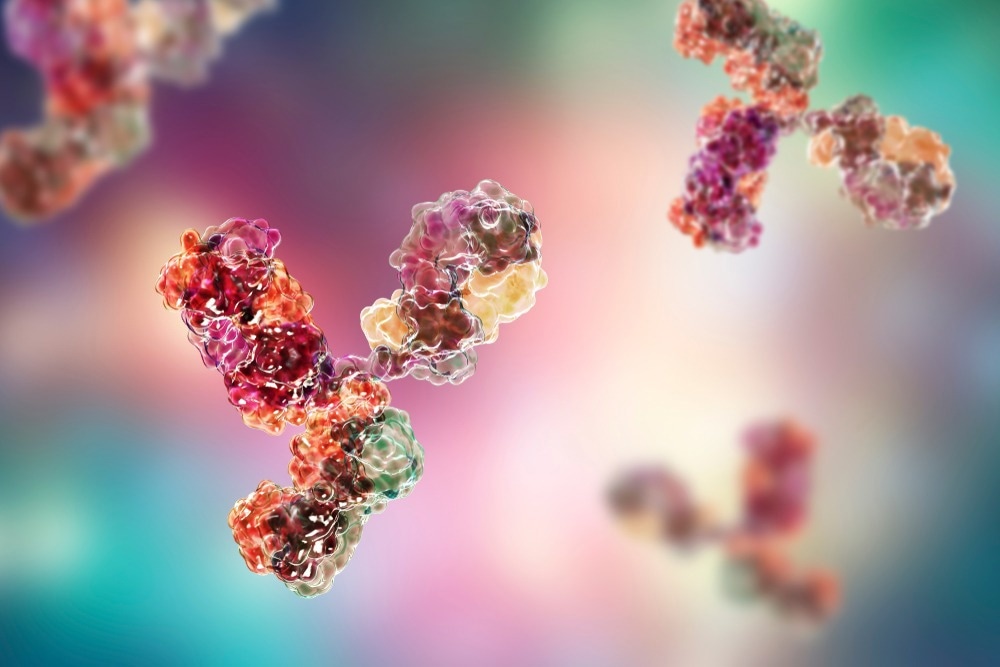In a recent study published in Nature Communications, a group of researchers assessed CSX-1004, a monoclonal antibody (mAb), for its efficacy in reversing fentanyl overdose based on its high affinity for fentanyl, positive animal model results, and safe pharmacokinetic profile, positioning it as a potential solution in the opioid crisis.
 Study: Investigation of monoclonal antibody CSX-1004 for fentanyl overdose. Image Credit: Kateryna Kon/Shutterstock.com
Study: Investigation of monoclonal antibody CSX-1004 for fentanyl overdose. Image Credit: Kateryna Kon/Shutterstock.com
Background
The opioid crisis in the United States (U.S.) has escalated with opioid-related deaths, largely due to illicit fentanyl and its analogs, reaching 74,808 in a year, accounting for 90% of opioid fatalities. The ability of fentanyl to get into mu-opioid receptor sites fast, coupled with high potency, is why fentanyl has a higher abuse susceptibility.
Naloxone is currently used as an antidote for opioid overdose, though its application is not extended to prophylaxis measures; besides, its effects do not last for long. The problem manifests itself in fentanyl overdoses, particularly in WCS cases. Furthermore, most cases of an overdose occur alone, and hence naloxone is not given on time. Therefore, there is an urgent requirement for more research leading to the development of potent, sustained therapeutics for the same.
About the study
In the present study, all research protocols were approved by respective Institutional Animal Care and Use Committees (IACUCs), adhering to ethical regulations. Mouse experiments of the Scripps Research Institute in testing the effectiveness of CSX-1004 against fentanyl were performed using six-eight week old Swiss Webster.
An adherent rat toxicology study at the Illinois Institute of Technology Research Institute, in accordance with good laboratory practice principles, had an equal number of male and female Sprague Dawley rats employed to ascertain the safety and pharmacokinetics of CSX-1004. Non-human primate (NHP) studies involving squirrel monkeys were carried out at McLean Hospital to assess the translational efficacy of CSX-1004 against fentanyl and its selectivity towards other opioids.
For surface plasmon resonance (SPR) testing, various fentanyl derivatives and opioid peptides were sourced from Cayman Chemical or Sigma Millipore. Compounds such as fentanyl hydrochloride, carfentanil, and naloxone hydrochloride are made in phosphate buffered saline in mice studies. In various animal studies, CSX-1004 came from either KBI Biopharma or in-house manufacturing. For NHP studies, opioids were provided by the National Institute on Drug Abuse (NIDA)/ National Institute of Health (NIH) Drug Supply Program, and CSX-1004 was supplied by Cessation Therapeutics.
Direct SPR binding assays were conducted using a Biacore S200 instrument, while competitive assays employed a Biacore 3000 instrument, both involving detailed procedures to measure the binding kinetics of CSX-1004 to fentanyl derivatives. Female Swiss Webster mice were used in studies examining the reversal of fentanyl antinociception and respiratory depression. NHP studies utilized adult squirrel monkeys for respiration studies. They were conducted in a custom-made whole-body plethysmograph with various experimental phases to assess the effects of CSX-1004 and other opioids.
Data analysis and statistics were conducted using a within-subject design, allowing each subject to serve as its control. Various software tools, including GraphPad Prism and PKAnalix, were utilized for data analysis, ensuring a comprehensive evaluation of the results.
Study results
CSX-1004, a fully human IgG1λ mAb, was developed through a process involving immunization of OmniRat with an opioid conjugate vaccine and subsequent B-cell sorting with opioid affinity probes. The antibody's opioid binding profile was determined using SPR, revealing high affinity for a wide range of fentanyl analogs (FAs). CSX-1004 demonstrated notable flexibility in binding across various modifications at the R1, R2, and R3 positions of FAs. However, alterations at R4, R5, and R6 positions resulted in a decrease in affinity, with certain substitutions almost entirely abolishing binding.
In mouse models, CSX-1004 effectively reversed fentanyl-induced antinociception and significantly mitigated respiratory depression caused by carfentanil, an analog more potent than fentanyl. The reversal effect was rapid and sustained, showcasing the potential of CSX-1004 as a treatment for opioid overdose. Furthermore, the antibody was found to bind fentanyl in treated mouse serum, indicating a strong correlation between antibody concentration and fentanyl binding.
The safety and pharmacokinetic (PK) profile of CSX-1004 were evaluated in a rodent model following Good Laboratory Practice (GLP) standards. Rats administered varying doses of the antibody showed no significant adverse effects, and the pharmacokinetic parameters were consistent across the study. Additionally, an in vitro tissue cross-reactivity (TCR) assay revealed no significant binding of CSX-1004 to a range of normal human tissues, suggesting a favorable safety profile. The PK profile in monkeys mirrored that in rats, with a slightly longer elimination half-life.
In a NHPmodel, CSX-1004 demonstrated the ability to provide multi-week protection from fentanyl-induced respiratory depression. The antibody significantly flattened the fentanyl dose-response curve, indicating a marked shift in potency and prolonged efficacy. The effect was both dose and time-dependent, with the highest dose showing sustained impact over several weeks.
The specificity of CSX-1004 was further highlighted in studies involving other opioids. While the antibody effectively reduced the potency of fentanyl in various assays, it did not affect the dose-response curves of non-fentanyl opioids like alfentanil, oxycodone, and morphine. This selectivity aligns with the predicted in vitro binding profile of the antibody.
Additionally, CSX-1004 alone did not impact normal respiration, further supporting its potential as a targeted treatment for fentanyl overdose without affecting the efficacy of other opioids. These findings underscore the potential of CSX-1004 as a novel therapeutic strategy in combating opioid overdoses, specifically those involving fentanyl and its potent analogs.